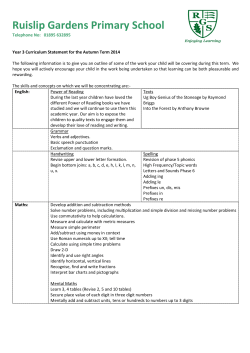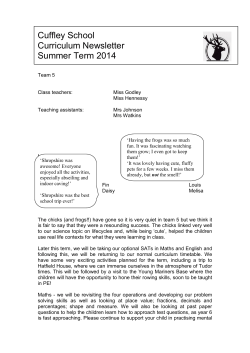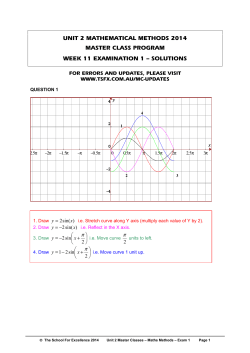
Module 1 4 Week Modular Course in Geometry & Trigonometry Strand 2
4 Week Modular Course in Geometry & Trigonometry Strand 2 Module 1 © Project Maths Development Team – Draft Junior Certificate Synthetic Geometry Axioms Concepts Set, plane, point, line, ray, angle, real number, length, degree, triangle, right-angle, congruent triangles, similar triangles, parallel lines, parallelogram, area, tangent to a circle, subset, segment, collinear points, distance, midpoint of a segment, angle, ordinary angle, straight angle, null angle, full angle, supplementary angles, vertically-opposite angles, acute angle, obtuse angle, angle bisector, perpendicular lines, perpendicular bisector of a segment, ratio, isosceles triangle, equilateral triangle, scalene triangle, right-angled triangle, exterior angles of a triangle, interior opposite angles, hypotenuse, alternate angles, corresponding angles, polygon, quadrilateral, convex quadrilateral, rectangle, square, rhombus, base and corresponding apex and height of triangle or parallelogram, transversal line, circle, radius, diameter, chord, arc, sector, circumference of a circle, disc, area of a disc, circumcircle, point of contact of a tangent, vertex, vertices (of angle, triangle, polygon), endpoints of segment, arms of an angle, equal segments, equal angles, adjacent sides, angles, or vertices of triangles or quadrilaterals, the side opposite an angle of a triangle, opposite sides or angles of a quadrilateral, centre of a circle. In addition for JCHL – concurrent lines Syllabus pages 68 &69 © Project Maths Development Team – Draft Recall and use of: 1. Two point axiom 2. Ruler axiom 3. Protractor Axiom 4. Congruent triangles 5. Axiom of parallels Constructions Ordinary Level: 13 Constructions Higher Level: 15 Constructions Theorems Application of theorems, converses and corollaries to solve problems Ordinary Level: 10 Theorems 1 Converse 1 Corollary Higher Level: 14 Theorems 5 Formal proofs 1 Converse 5 Corollaries Ready Reckoner © Project Maths Development Team – Draft Resources All available from: http://www.projectmaths.ie © Project Maths Development Team – Draft Concepts © Project Maths Development Team – Draft Theorems: A Discovery Approach “Theorems are full of potential for surprise and delight. Every theorem can be taught by considering the unexpected matter which theorems claim to be true. Rather than simply telling students what the theorem claims, it would be helpful if we assumed we didn’t know it… it is the mathematics teacher’s responsibility to recover the surprise embedded in the theorem and convey it to the pupils. The method is simple: just imagine you do not know the fact. This is where the teacher meets the students”. Van Hiele Model of Geometric Taught © Project Maths Development Team – Draft Definition 25 Given two lines AB and CD, and a transversal AE of them, as in fig (a), the angles EAB and ACD are called corresponding angles, with respect to the two lines and the given transversal. E B A D C fig (a) © Project Maths Development Team – Draft Theorem 5 (Corresponding Angles) Two lines are parallel if and only if for any transversal, corresponding angles are equal. Approaches: 1. Drawing Students discover the theorem using ruler and protractor. 2. Geostrips Let’s examine the use of Geostrips for theorems in the classroom 3. Student CD How can the Student CD and Student Activity Sheet help? © Project Maths Development Team – Draft Application of Theorem 5 Periscope © Project Maths Development Team – Draft Theorem 14 (Pythagoras) In a right-angled triangle the square of the hypotenuse is the sum of the squares of the other two sides. Monument to Pythagoras in his birthplace, Samos. © Project Maths Development Team – Draft Theorem 14 (Pythagoras) In a right-angled triangle the square of the hypotenuse is the sum of the squares of the other two sides. Approaches: 1. Drawing Construction on squared paper. 2. Cut - out Two activity sheets. 3. Perigal’s Dissection One of many illustrations of Pythagoras Theorem. 4. Student CD. How can the Student CD and Student Activity Sheet help? © Project Maths Development Team – Draft Applications of Theorem 5 and its Converse Marking out a Site Checking for Square On the left we have a sketch of say an "L" shaped building. When builders are setting it out, after putting pegs in the three main corners, they want to check for square before getting the rest of the profiles fixed. They work out the length of the red dotted line to check for a right angle. © Project Maths Development Team – Draft Cable Stay Bridges Cable Stayed Bridges Problem Suppose an engineer has to design the cable supporting the bridge deck. If the concrete tower is 150m above the road deck and the support point for the main cable is 100 m away from the tower, how long does the cable have to be? Solution c2 a2 b2 a 100 m b 150 m c a2 b2 c 1002 1502 c 10000 22500 c 32500 c 180.28m © Project Maths Development Team – Draft Practical Problem 1 Given that the second story window is 4.5 m above the ground and the only sure footing for the ladder is at least 2m from the house, can a window cleaner who has a ladder of length 5m reach the window to clean it? Practical Problem 2 The dimensions of your TV cabinet are 18" by 24". You want to buy a TV with a 27" screen in the 16 : 9 format. Check to see if it will fit in your cabinet before you go and purchase it? © Project Maths Development Team – Draft A Greek in an Italian Restaurant Can you see Pythagoras in the floor of this Italian restaurant? http://www.qedcat.com/archive/32.html Some More Applications Triangulation helps to locate a cell phone making an emergency call. It might use the Sine Rule to find the phone. The law of cosines can also reduce to the Pythagorean theorem. Pythagoras’ theorem is used in fractal geometry e.g. Movie and Video game environments are drawn in 3-D using triangles. © Project Maths Development Team – Draft Towards Geometric Proofs Consider a geometry wall: the foundations of the wall consist of the early axioms and definitions. Each conclusion builds upon previous knowledge. The cement holding the wall together is the deductive logic that is used to prove the next theorem. Definition 26: Exterior Angle Definition 25: Corresponding Theorem 2: Isosceles triangles Definition 21 Isosceles Definitions 4 - 17 Two Points Axiom. Axiom 1 Ruler axiom 2. Axiom 2 © Project Maths Development Team – Draft Theorem 3: Alternate Angles Definition 22 - 23 Definition 18: Complementary Angles Theorem 5: Corresponding Definition 24: Alternate Theorem 1: Vertically opposite Angles Protractor axiom 3 Axiom 3 Theorem 4: Angle sum 180o Definition 1: Line segment Axiom of parallels Axiom 5 Congruency Axiom 4 Definition 19 - 20 Definition 2: Collinear Definition 3: Triangle Theorem 6 The exterior angle of a triangle is equal to the sum of the interior remote angles. Approaches: 1. Proof Interactive Proof. 2. Student CD. How can the Student CD and Student Activity Sheet help? © Project Maths Development Team – Draft Other Shapes Pythagorean Triples Take any two whole numbers and form: 1. The difference between their squares. 2. Twice their product. 3. The sum of their squares. Proof : Let a n2 m2 , b 2nm and c n2 m2 , where n m (n2 m2 )2 (2mn)2 n4 2n2m2 m4 4n2m2 n4 2n2m2 m4 (n2 m2 )2 © Project Maths Development Team – Draft Constructions Ordinary Level: 13 Constructions. Higher Level: 15 Constructions © Project Maths Development Team – Draft Ready Reckoner © Project Maths Development Team – Draft Construction 5 Line parallel to given line, through a given point. Approaches: 1. Instructions Use any method, animated or otherwise, to show the steps of the construction. 2. Students using their mathematical instruments Have instructions on board as they are working out their construction. 3. Student CD. How can the Students CD and Student Activity Sheet help? © Project Maths Development Team – Draft
© Copyright 2025









